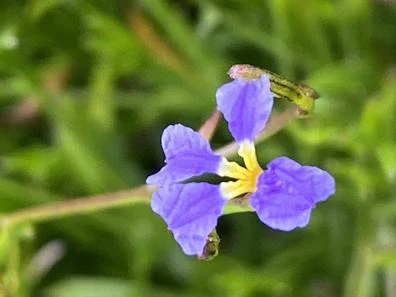Angled-Stem Dampiera
(Dampiera trigona)
Angled-Stem Dampiera (Dampiera trigona)
/
/

Allthingsnative
CC BY-SA 4.0
Image By:
Allthingsnative
Recorded By:
Copyright:
CC BY-SA 4.0
Copyright Notice:
Photo by: Allthingsnative | License Type: CC BY-SA 4.0 | License URL: https://creativecommons.org/licenses/by-sa/4.0 | Uploader: Allthingsnative | Publisher: Wikipedia Commons



Estimated Native Range
Climate Requirements for Dodge City, Kansas
| This Plant | Your Site | Plant Suitability for Your Location | ||
|---|---|---|---|---|
| • Precipitation | 17" - 49" | 22" | Your precipitation may be insufficient for this plant. Irrigate N" / year. | Irrigate N" / year |
| • High Temp. | 74°F - 94°F | 93°F | Your summer temperatures are normal for this plant. | Excellent |
| • Low Temp. | 33°F - 50°F | 18°F | Your winter temperatures may be too cold for this plant | Too cold |
This plant should grow well at your location with about N inches per year (Y minutes per month) of irrigation.
Summary
Dampiera trigona, commonly known as Angled-Stem Dampiera, is an evergreen subshrub native to the sandy soils and coastal heathlands of Southwestern Australia. It typically grows to a height of 0.8-1 feet (0.2-0.3 meters) and spreads 2-3 feet (0.6-0.9 meters) wide. The plant has a compact, mounding form with angled stems, and it produces vibrant blue and purple flowers during the spring and summer months, which are moderately showy and attract pollinators.
Angled-Stem Dampiera is valued for its drought tolerance once established and its ability to thrive in poor soils, making it a suitable choice for rockeries, coastal gardens, and as a ground cover in sunny areas. It is also used for its ornamental flowers and as a low-maintenance plant in water-wise gardens. In cultivation, it prefers full sun exposure but can tolerate light shade, requires moderate watering, and performs best in well-drained soils. While generally pest-free, it can be susceptible to root rot in poorly drained conditions.CC BY-SA 4.0
Angled-Stem Dampiera is valued for its drought tolerance once established and its ability to thrive in poor soils, making it a suitable choice for rockeries, coastal gardens, and as a ground cover in sunny areas. It is also used for its ornamental flowers and as a low-maintenance plant in water-wise gardens. In cultivation, it prefers full sun exposure but can tolerate light shade, requires moderate watering, and performs best in well-drained soils. While generally pest-free, it can be susceptible to root rot in poorly drained conditions.CC BY-SA 4.0
Plant Description
- Plant Type: Shrub
- Height: 0.8-1 feet
- Width: 1.5-3 feet
- Growth Rate: Moderate
- Flower Color: Purple
- Flowering Season: Spring, Summer
- Leaf Retention: Evergreen
Growth Requirements
- Sun: Full Sun
- Water: Medium
- Drainage: Medium
Common Uses
Border Plant, Low Maintenance, Rock Garden, Showy Flowers
Natural Habitat
Sandy soils and coastal heathlands
Other Names
Common Names:
Scientific Names: Dampiera trigona , Dampiera trigona var. tenuis , Dampiera biloculata
GBIF Accepted Name: Dampiera trigona de Vriese